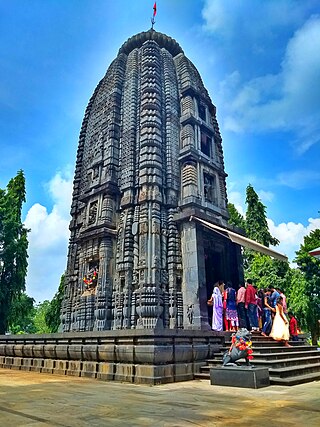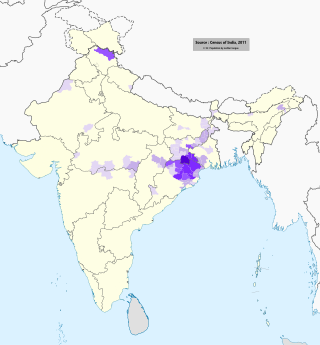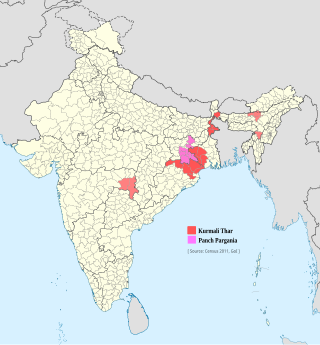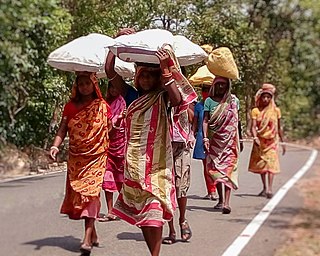
Mayurbhanj district is one of the 30 districts in the Odisha state of eastern India. It holds the distinction of being the largest district in Odisha by area. The district's headquarters is located in Baripada, with other major towns including Rairangpur, Karanjia, and Bahalda. As of 2011, Mayurbhanj ranks as the third-most populous district in Odisha, following Ganjam and Cuttack.

Ho is a Munda language of the Austroasiatic language family spoken primarily in India by about 2.2 million people per the 2001 census. It is spoken by the Ho, Munda, Kolha and Kol tribal communities of Odisha, Jharkhand, Bihar, Chhattisgarh, West Bengal, Assam and is written with the Warang Citi script. Devanagari, Latin script, Odia script and Telugu script are sometimes used, although native speakers are said to prefer a Ho script. The latter script was invented by Ott Guru Kol Lako Bodra.

The Munda people are an Austroasiatic-speaking ethnic group of the Indian subcontinent. They speak Mundari as their native language, which belongs to the Munda subgroup of Austroasiatic languages. The Munda are found mainly concentrated in the south and East Chhotanagpur Plateau region of Jharkhand, Odisha and West Bengal. The Munda also reside in adjacent areas of Madhya Pradesh as well as in portions of Bangladesh, Nepal, and the state of Tripura. They are one of India's largest scheduled tribes. Munda people in Tripura are also known as Mura.

The Kharia are an Austroasiatic tribal ethnic group from east-central India. They originally speak the Kharia language, which belong to Austroasiatic languages. They are sub-divided into three groups known as the Hill Kharia, Delki Kharia and the Dudh Kharia. Amongst them, the Dudh Kharia is the most educated community.

The Baiga are an ethnic group found in central India primarily in the state of Madhya Pradesh, and in smaller numbers in the surrounding states of Uttar Pradesh, Chhattisgarh and Jharkhand. The largest number of Baiga is found in Baiga-chuk in Mandla district and Balaghat district of Madhya Pradesh. They have sub-castes: Bijhwar, Narotia, Bharotiya, Nahar, Rai maina and Kath maina. The name Baiga means "sorcerer-medicine man".

Kendujhar District, is an administrative district of Odisha. The district is one of the fifth Scheduled Areas of Odisha. The town of Kendujhar is the district headquarters. The district has three sub-divisions, Anandapur, Champua, and Kendujhar.
Sundhi also known as Sodhi or Sundi or Sudi or Sudhi or Shoundika, is an Indian caste whose traditional occupation has been brewing of alcoholic drinks. The Sundhis are included in the Other Backward Class category in the states of Bihar, Jharkhand and Odisha, though according to Suratha Kumar Malik, Sundhis of Koraput district of Odisha belong to the Dalit community, who are hooch traders and do small businesses. They are considered as Scheduled Caste in West Bengal, where they are also known as Shunri.

Bagata people are one of the tribal ethnic groups of India, mainly concentrated in Andhrapradesh and Odisha. As per the Indian constitution, they are designated as Scheduled Tribe for affirmative action.
Bauri (Bengali:বাউরী) is a community of indigenous people primarily residing in Bengal, and considered as one of the Scheduled Castes of India. The Bauris belong to the Bhil tribe. They are usually involved in activities like farming. The Bauris of Purbo Tila Moulvibazar in Bangladesh are usually involved in medicinal practices. The prime festivals they celebrate are known as Mansa Puja, Durga Puja and Kali Puja.

Bhumij is a Munda ethnic group of India. They primarily live in the Indian states of West Bengal, Odisha, Assam and Jharkhand, mostly in the old Singhbhum district. Also in states like Bihar and Assam. There is also a sizeable population found in Bangladesh. Bhumijas speak the Bhumij language, an Austroasiatic language, and use Ol Onal script for writing.
Lodha people are one of Schedule Tribes and PVTGs of India, primarily living in West Bengal and Odisha. Lodhas of West Bengal mostly live the Paschim Medinipur and Jhargham districts. A section of the Lodha has converted to Islam, and formed a distinct community called the Lodha Muslims.

Kurmali or Kudmali is an Indo-Aryan language classified as belonging to the Bihari group of languages spoken in eastern India. As a trade dialect, it is also known as Panchpargania, for the "five parganas" of the region it covers in Jharkhand. Kurmali language is spoken by around 550,000 people mainly in fringe regions of Jharkhand, Odisha and West Bengal, also a sizeable population speak Kurmali in Assam tea valleys. Kurmali is one of the demanded languages for enlisting in Eighth Schedule to the Constitution of India.

The Bhuiyan or Bhuiya are an indigenous community found in the Indian states of Bihar, Jharkhand, Madhya Pradesh, Odisha, Uttar Pradesh and West Bengal. They are not only geographically disparate but also have many cultural variations and subgroups.

Sarnaism is a religious faith of the Indian subcontinent, predominantly followed by indigenous communities in the Chota Nagpur Plateau region across states like Jharkhand, Odisha, West Bengal, Bihar, and Chhattisgarh.
The Kudmi Mahato are a tribal community in the states of Jharkhand, West Bengal and Odisha of India. They are primarily agriculturalist.
Mahto or Mahato is a surname used by several castes and communities in the states of Bihar, Jharkhand, West Bengal, Uttar Pradesh and Odisha in India. Mahato is also a popular surname in Nepal. In the zamindari villages, "Mahto" was a title given to the headman of a village ward. The mahto's duties were to maintain peace in his area, and collect revenue for the zamindar. In Chotanagpur plateau region of Jharkhand, including in the Oraon tribal society, Mahato was historically a title of the village chief. In Bihar, the surname Mahto is primarily used by people belonging to Kushwaha caste. While in Jharkhand, it is a term most often associated with Koeri and Kurmi caste.
The Nagpuria people, also Nagpuri or Sadan, are an Indo-Aryan speaking ethnolinguistic group who are the native speakers of the Nagpuri language and natives of the western Chota Nagpur Plateau region of Indian states of Jharkhand, Bihar, Chhattisgarh and Odisha.
Gopal or Gouda is an Indian caste, from Odisha State in East India. Their traditional occupations include dairy farming, cattle herding, cultivation and carrying palanquins of deities. They also worked as Paikas (soldiers) under the kings. Gopal is the name of the milkmen or herdsmen caste in Odisha, which is known by other names in various parts of India.

Bagal is a cattle herding caste of East India. Bagal people are living in the state of West Bengal, Jharkhand and Odisha. They use Kudmali/ Manbhumi dialect of Bengali as mother tongue and use Bengali, Hindi and Odia language to communicate with the society.












